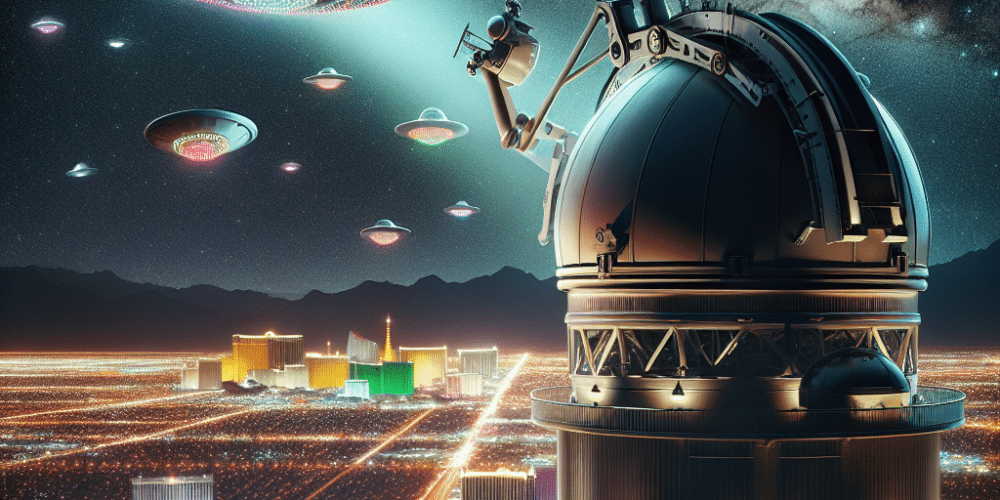High above the glittering lights of the Las Vegas Sphere, a new technological marvel is capturing more than just the attention of “The Wizard of Oz” fans. The Galileo Observatory, conceptualized by renowned Harvard astrophysicist Avi Loeb, is on a mission to scrutinize the skies for something far more enigmatic than fantastical flying monkeys.
Perched atop the Sphere, the Galileo Observatory is designed to track Unidentified Anomalous Phenomena, commonly known as UFOs. Avi Loeb, who holds the Frank B. Baird Jr. Professorship at Harvard’s Center for Astrophysics, explained that this novel system is equipped with ultra-high resolution optical and infrared cameras. These instruments feed data into advanced AI systems, which aim to eliminate human bias and expedite the analysis process.
The observatory’s capabilities are enhanced by its triangulation with two additional observatories situated approximately 10 kilometers away, their exact locations undisclosed. This network allows scientists to precisely measure an object’s velocity, acceleration, and its distance from Earth, bringing a level of scientific rigor that is rare in the field of UAP research.
In September 2024, the project received its final approval. This milestone was marked by a meeting between Loeb and James Dolan, the CEO of Sphere Entertainment, at Loeb’s home in Boston, where Dolan endorsed the installation of the observatory above the Exosphere’s LED display. Coincidentally, the observatory became operational just as “The Wizard of Oz” began its screenings in late August, providing a fitting backdrop for visitors enjoying tales of other worlds while scientists conduct their celestial investigations above.
The Galileo Observatory aims to scrutinize millions of objects each year, as Loeb outlined in a post on Medium. Despite the skepticism and even ridicule he faces from some of his peers, Loeb remains steadfast in his belief that some UAPs could potentially have extraterrestrial origins. He hopes that the observatory might one day capture evidence of visitors far more intelligent than current academic circles often contemplate.
This project is ambitious, not only in its scale but also in its vision. The goal is not merely to catch a fleeting glimpse of something out of the ordinary but to gather robust, verifiable data on phenomena that have intrigued humanity for generations. As tourists in Las Vegas watch Dorothy’s journey into Oz, scientists are simultaneously gazing toward the cosmos, searching for wonders that may come from beyond our world.
However, not everyone is confident in the potential outcomes of the Galileo Observatory’s mission. Critics argue that the vast resources and attention allocated to such projects might be better used to address more terrestrial concerns. They caution against reading too much into phenomena that could have mundane explanations, such as atmospheric anomalies or experimental technology. Still, the allure of answering the age-old question of whether we are alone in the universe is a powerful motivator for many involved in the project.
The Galileo Observatory symbolizes a convergence of cutting-edge technology and timeless curiosity. It is a testament to humanity’s enduring desire to explore the unknown, driven by a blend of scientific inquiry and imaginative wonder. With Las Vegas as a backdrop—a city known for its boldness and flair—the observatory embodies a spirit of exploration and discovery.
While some view the project with skepticism, considering it a detour from more pressing scientific endeavors, others see it as a necessary step forward. After all, history has shown that some of the most profound discoveries often emerge from the pursuit of questions that once seemed unanswerable. The potential to uncover evidence of extraterrestrial life, though uncertain, offers a glimpse into what could be the next great leap in human understanding.
Ultimately, the Galileo Observatory stands as a beacon of hope and curiosity, urging us to look beyond the known and into the vast, unexplored realms of space. Whether it finds what it seeks or not, the journey itself promises to enrich our perspective, challenging both scientists and the public to entertain the possibilities that lie just beyond our reach. As the search continues, so does the conversation about our place in the universe, a dialogue as old as humanity itself.

David Harrison stands tall in gambling journalism, marrying his firsthand casino experiences with a deep understanding of betting psychology. His articles transform complex gambling jargon into engaging tales of strategy and chance, making the world of betting accessible and enjoyable. David’s knack for narrative extends beyond print, making him a sought-after speaker on gambling trends and future bets. In the realm of gambling, David is both a scholar and a storyteller, captivating readers and listeners alike.
















